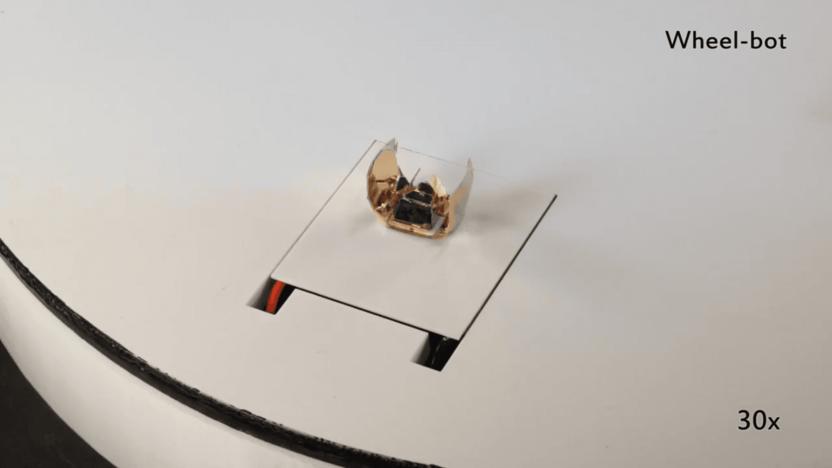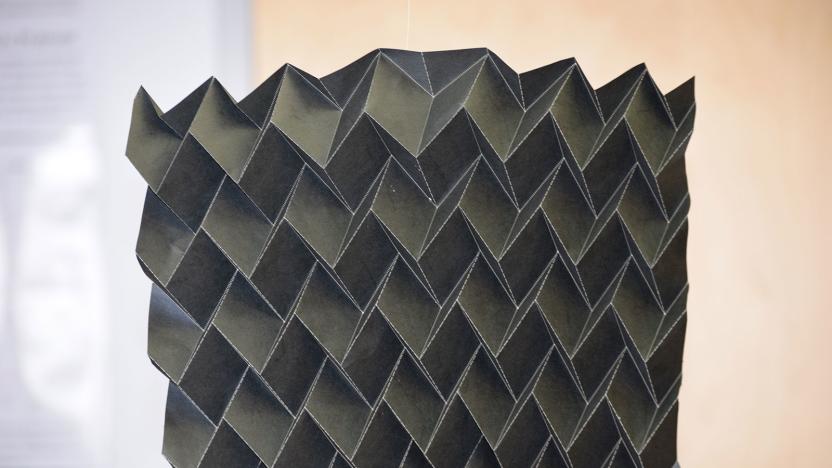origami
Latest

Origami-like patch could help robot surgeons repair internal injuries
MIT researchers have developed an origami-style medical patch robot surgeons could use to repair internal injuries.

Cornell University's laser-activated robot is smaller than a paramecium
Researchers from Cornell University unveiled an entire robot that is teensy enough to fit most anywhere in the human body — yes, even in there — and inexpensive enough to produce on a mass scale. The walking robots are the creation of Cornell physics professor Itai Cohen, professor of physical science Paul McEuen, and assistant professor at the University of Pennsylvania, Marc Miskin.

The tiny house craze has gone too far
Researchers in France have built a teeny, tiny house. It's just a few micrometers wide, too small for even a mite to fit inside, and demonstrates that a focused ion beam and a small robot can create 3D microstructures with incredible accuracy and precision. "For the first time we were able to realize patterning and assembly with less than two nanometers of accuracy, which is a very important result for the robotics and optical community," Jean-Yves Rauch, a researcher on the project, said in a statement. The work was published recently in the Journal of Vacuum Science and Technology A.

MIT CSAIL's origami-bot wears foldable exosuits
Unless alien machines that can turn into cars and trucks come and teach us their secrets, we'll have to conjure up our own ways to make transforming robots. Researchers from MIT CSAIL have been on it for years, and their latest method relies on a cube robot called "Primer" that changes shape and function by donning different exoskeletons. Primer, which was based on the cube-shaped machines the team developed in 2013, starts the process by moving to the center of the exoskeletons that start as flat sheets. After applying a bit of heat on the sheets, they fold into specific shapes using Primer as a core, turning into a boat, a glider or a wheel.

NASA wants your origami ideas for its spacecraft radiation shield
NASA needs ideas on how to design a radiation shield for deep space vehicles, and it's turning to origami artists and enthusiasts for help. If you're skilled in the art, that includes you. The space agency has teamed up with crowdsourcing website Freelancer to launch a project challenging people to create an origami design showing the most efficient way to pack a radiation shield. It's a necessary component for manned missions, since cosmic rays can damage both human bodies and electronics. Without a shield, future spacefarers will be more prone to developing cancer, degenerative tissue damage, nervous system damage, heart disease and cataracts.

NASA's origami robots can squeeze into places rovers can't
Imagine a Martian rover that can send small robotic minions to crawl into crevices or climb steep slopes -- everywhere a full-sized vehicle can't go to. That's the scenario a team from NASA's Jet Propulsion Laboratory hopes to achieve by developing small origami-inspired robots called Pop-Up Flat Folding Explorer Robots or PUFFERs. They're made of printed circuit boards and can be flattened and stacked on top of each other on the way to their mission. Once they get to the location, they can pop back up and drive away.

ICYMI: Bulletproof origami shields and hoverbikes
Today on In Case You Missed It: Finally, the best part of Return of the Jedi is becoming a reality. Hoversurf Inc. is building actual hoverbikes for folks to ride. Well, not right away. It'll be a few years before you can buy one. But at least we can start saving all your nickels and dimes for a time when we can go barreling through the Redwoods like Luke and Leia.

NASA's new satellite radiator is a work of art
Satellite radiators are typically huge and heavy -- not at all ideal for tiny spacefarers like CubeSats. To address small satellites' need, NASA Goddard technologist Vivek Dwivedi has teamed up with Brigham Young University scientists to develop a "smart" radiator inspired by origami. The three-dimensional structure made out of temperature-sensitive materials like shape-memory alloys can fold and unfold to preserve and shed heat, respectively. It also folds when it wants to soak up heat from the sun or the Earth, because the team found that the deeper the cavities, the greater the absorption.

The best of CEATEC 2016: virtual tea, printed makeup, too many robots
Panasonic showed off a TV that hides in plain sight, there were gesture controlled origami birds, and a TARDIS-shaped machine that could 3D scan your entire body in four seconds flat. That's the kind of show CEATEC is. There were even more robots, and while some of them might have a future, many may never be seen again. And that's okay. Here's everything we saw, and you can find all the best bits in the video above.

ICYMI: Insect robot for kids, paralysis fixed and more
#fivemin-widget-blogsmith-image-184110{display:none;} .cke_show_borders #fivemin-widget-blogsmith-image-184110, #postcontentcontainer #fivemin-widget-blogsmith-image-184110{width:570px;display:block;} try{document.getElementById("fivemin-widget-blogsmith-image-184110").style.display="none";}catch(e){}Today on In Case You Missed It: We are covering the drone guideline news from the FAA the only way we know how: With some silly videos and real ones as well, like the Google X drone delivery test video -- all to warn you all that UAV regulations are finally coming. A new Kickstarter for a toy insect robot comes with origami-like assembly, to teach kids about coding and engineering. And scientists at Ohio's Case Western Reserve University have electronically bridged a gap between a paralyzed person's spinal column and arms using brain wave sensors, in effect letting him use his arms once again.

This paper origami bird actually flies
Origami and technology go together pretty well. Lightweight, efficient structures... and animal shapes. But there's nothing more "origami" than the humble paper crane. Now, courtesy of a small, light, power-efficient microcomputer from Rohm (a Japanese company: don't let the name fool you), the crane can fly. Better still, it's remote-controlled and can even keep itself afloat for around five minutes, according to the spokesperson. It's almost the most Japanese thing here at this year's CEATEC. Almost.

4-gram 'Tribot' shows off heat-activated high jumping
At the École Polytechnique Fédérale de Lausanne (EPFL), a laboratory that specializes in origami robots has created one that was inspired by the inchworm. The tiny 4-gram machine called "Tribot" can crawl, jump seven times its height and then resume crawling without any resting period in between. Since Jamie Paik's team at the Reconfigurable Robotics Laboratory couldn't use typical bulky motors to create a light and foldable machine, they had to use titanium and nickel "shape memory alloy" to build actuators and springs for it. Tribot crawls by heating those memory alloy parts with an electric current -- the heat makes its limbs "remember" or pop back to their original shape after expanding. In the video below, you can watch the researchers discuss both Tribot and the other origami robot they're developing, a four-limbed "Crawler."

Kirigami-inspired solar cells can track the sun without motors
Researchers at the University of Michigan announced on Wednesday that they have developed a method of keeping solar cells turned toward the sun without the need for heavy and energy-hungry motors. Their method is based on the Japanese art of Kirigami -- like origami but with cuts in addition to folds. The team's panel is printed on a flexible kapton substrate which has dash-like cuts running across its surface. When stretched, the panel forms a mesh with each section twisting slightly. The degree of twist, which will allow the panel to follow the path of the sun, depends on how much the panel is stretched. "The design takes what a large tracking solar panel does and condenses it into something that is essentially flat," Aaron Lamoureux, lead author on the paper published in Nature Communications, said in a release.

Batteries that stretch are perfect for smart watches and clothes
Used to be that the only time your lithium-ion batteries changed their shape was when they were about to explode in an airliner cargo hold. But thanks to the ingenuity of an Arizona State University research team, future power packs could not only bend but stretch up to 150 percent of their original size while providing an uninterrupted stream of power. Their secret: the ancient Japanese art form of Kirigami. It's an offshoot of the more well-known Origami form that involves both folding and cutting the working material.

Bacteria-powered folding batteries could power paper biosensors
We've seen flexible displays for some time now, and engineers at Binghamton University developed an origami-inspired foldable battery. The folding part is great, but these batteries are also powered by bacteria and made from paper, providing an low-cost option for remote locales where resources are scarce. That all sounds good, but what are the potential uses? Well, paper-based biosensors have been around for a bit too, but they usually have to be paired with some sort of device to be of any use. The goal is to create tech that allows those sensors to power themselves. Currently, the battery folds down to about the size of a matchbook and costs five cents to make.

NASA researchers use extreme origami to build space solar panels
Here's the dilemma: rockets have only so much space, yet satellite solar panels are much more useful when they're big. The solution? Make them foldable using the ancient art of Japanese origami. Researchers at Brigham Young University (BYU) and NASA's Jet Propulsion Laboratory have figured out how to one day create an array 8.9 feet in diameter that could unfold to 82 feet wide. A panel that size could generate 250 kilowatts of power, compared to the current maximum of about 14 kilowatts. The 1/20 scale prototype starts as a satellite-friendly cylindrical form and expands to a flat, 4.1 foot circular shape by the application of a single force (see the video below). The research was inspired by a technique called the "Miura fold," originally developed for a Japanese satellite by astrophysicist Koryo Miura. A larger version could one day beam solar energy back to earth, or even power future spacecraft -- especially now that microwave thrusters are feasible. [Image credit: Mark A. Philbrick/BYU]

Engadget Daily: the culture of leaks, surviving music festivals and more!
Today, we investigate the culture of leaks, learn how to enhance your music festival experience, review the first Chromebook to feature an i3 processor, watch a robot assemble itself and more. Read on for Engadget's news highlights from the last 24 hours.

Craft your own paper Journey traveler
If anyone would know how to make an adorable hooded traveler out of paper, it's the art director for Journey, Matt Nava. Nava created a step-by-step guide to crafting your own traveler, oragami-style, and developer thatgamecompany shared it with the world on Facebook. Scroll through the comments to see some fans' completed figures, big, small, colorful and blank. Click the image below for a large version of the origami instructions. [Image: Matt Nava]

Amazon offering up Origami covers for those fancy new Kindle Fires
So, imagine you just shelled out $200 or $300 for one of those new Kindle Fire HDXs, only to have it scratch in your backpack as you pull it out to gloat to one of your friends. Oh, you poor, poor soul. If only you'd had the foresight to pick up an Origami cover. Like the new tablets, the case goes up for pre-order today -- and will start shipping at the same time as their respective devices. Jeff Bezos was pretty keen to show the accessories off today, demonstrating how built-in magnets allow them to fold together in such a way that the tablets can be positioned in either landscape or portrait modes. Neater still for the 8.9-inch version (the one with the rear-facing camera, mind), is a feature that triggers the photo app when the cover is slid down on the slate. Behold, magnetic magic that would leave the Insane Clown Posse pondering scientific inquiry for months to come. Amazon's made cases for both HDX models and the new HD. The polyurethane versions of the 7- and 8.9-inch HDX cases run $50 and $55, respectively, with the leather versions coming in at $65 and $70. The covers for the HD run $45 and $60. Philip Palermo contributed to this report.

Cardboard bicycle 'close to mass production': tough, green and just $20
Cardboard never ceases to amaze. Having been deployed in gramophones, stereos and even digital cameras, one inventor now believes it can be used to make the ideal bicycle. Izhar Gafni, from Israel, spent 18 months just folding the material every-which-way in order to discover a strong enough design, and now he claims his technique is almost ready for mass production. His maintenance-free bike uses a "secret" mix of organic materials to make it waterproof and fireproof, and is then lacquered to give it a friendlier appearance. It's expected to cost a mere $20 and weigh about 20 lbs (9 kg) -- that's 65 percent lighter than an average metal ride. In fact, this bicycle doesn't use any metal parts at all -- the solid tires are made of reconstituted rubber and a car timing belt is used instead of a chain. It lacks the swank of a Faraday Porteur, perhaps, but then you could buy 175 of these for the same money. Want proof that it actually works? The bike's not-so-featherweight inventor takes it for a spin after the break. [Image credit: Reuters / Baz Ratner]












